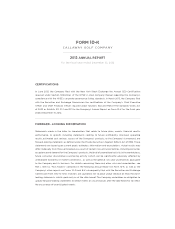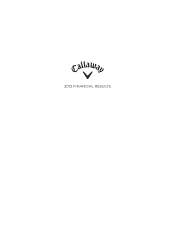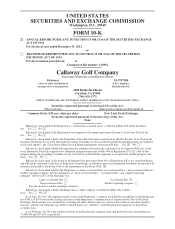Callaway 2012 Annual Report Download - page 17
Download and view the complete annual report
Please find page 17 of the 2012 Callaway annual report below. You can navigate through the pages in the report by either clicking on the pages listed below, or by using the keyword search tool below to find specific information within the annual report.robots, launch monitors, a proprietary virtual test center, a proprietary performance analysis system, an indoor
test range and other methods to develop and test its products. Through the use of these technologies, the
Company has been able to accelerate and make more efficient the design, development and testing of new golf
clubs and golf balls.
For certain risks associated with product design and development, see below, “Risk Factors” contained in
Item 1A.
Manufacturing
The Company has its primary golf club assembly facility in Monterrey, Mexico, and maintains limited golf
club assembly for certain custom club orders in its facilities in Carlsbad, California. Golf clubs are also assembled
in China and other local markets based on regional demand for custom clubs. In addition, the Company has a golf
ball manufacturing facility in Chicopee, Massachusetts, and also utilizes contract manufacturers in China and
Taiwan for golf balls. Both the golf club assembly process and golf ball manufacturing process utilize raw
materials that are obtained from suppliers both internationally and within the United States. At December 31, 2012
and 2011, most of the Company’s golf club production volume was made in regions outside of the United States.
With respect to golf balls, at December 31, 2012 and 2011, over 75% of production volume was made in regions
outside of the United States. The Company has third-party logistics sites in Dallas, Texas and Toronto, Canada for
the global distribution of goods.
Overall, the golf club assembly process is fairly labor intensive and requires extensive global supply chain
coordination. With respect to golf balls, although a significant amount of labor is used, the overall manufacturing
process is much more automated than the golf club assembly process.
During the third quarter of 2012, the Company reached an agreement in principle to sell its golf ball
manufacturing facility in Chicopee, Massachusetts, and lease back a reduced portion of the square footage to
eliminate unused space at the facility. In February 2013, the Company completed the sale of this facility and
entered into an agreement to lease back a reduced portion of the square footage to better align with current needs.
Raw Materials
The Company purchases raw materials from domestic and international suppliers in order to meet scheduled
production needs. Raw materials include steel, titanium alloys and carbon fiber for the manufacturing of golf
clubs, and rubber, plastic ionomers, zinc sterate, zinc oxide and lime stone for the manufacturing of golf balls. For
certain risks associated with golf club and golf ball manufacturing, see “Risk Factors” contained in Item 1A.
Sales and Marketing
Sales in the United States
Of the Company’s total net sales, approximately 47% was derived from customers within the United States in
both 2012 and 2011, and approximately 48% in 2010. The Company primarily sells to both on- and off-course
golf retailers and sporting goods retailers who sell quality golf products and provide a level of customer service
appropriate for the sale of such products. The Company also sells certain products to mass merchants. On a
consolidated basis, no one customer that distributes golf clubs or golf balls in the United States accounted for
more than 7% of the Company’s consolidated revenues in 2012, compared to 6% in both 2011 and 2010. On a
segment basis, in 2012, the top five golf club and golf ball customers accounted for approximately 14% and 17%
of the Company’s total consolidated golf club and golf ball sales, respectively. A loss of one or more of these
customers could have a significant adverse effect upon the Company’s golf ball sales.
Sales of the Company’s products in the United States are made and supported by full-time regional field
representatives and in-house sales and customer service representatives. Most regions in the United States are
covered by both a field representative and a dedicated in-house sales representative who work together to initiate
and maintain relationships with customers through frequent telephone calls and in-person visits. In addition to
these sales representatives, the Company also has dedicated in-house customer service representatives.
3
























